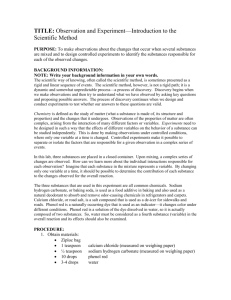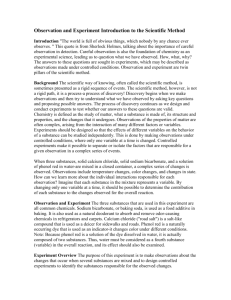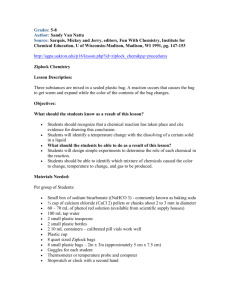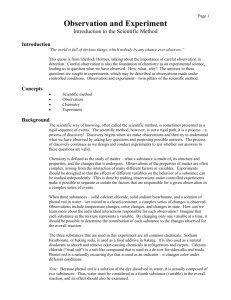Chemistry in a Ziploc Bag: Mini
advertisement
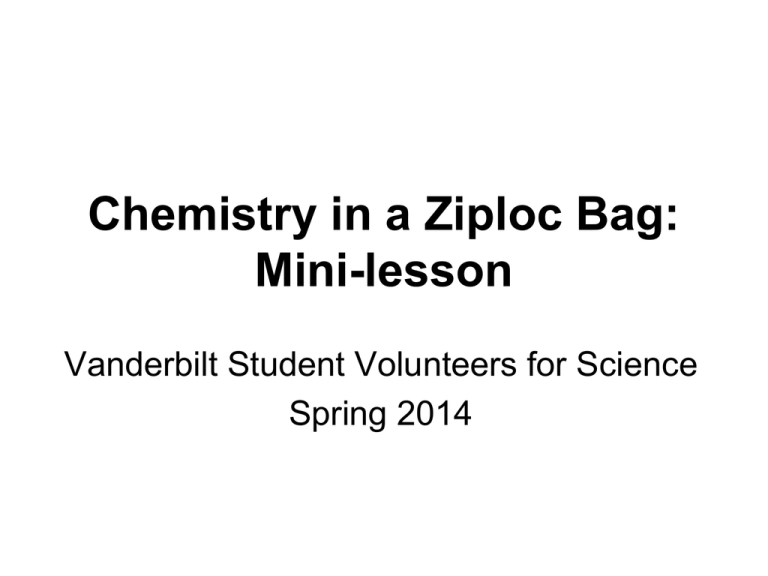
Chemistry in a Ziploc Bag: Mini-lesson Vanderbilt Student Volunteers for Science Spring 2014 I. Introduction •Tell students this lesson involves a chemical reaction that produces a gas. Warn them that the ziploc bag is going to fill up with air. •Assure students that the chemicals are safe. •For this experiment, students work in pairs. I. Preparation • Count students. Prepare enough cups for students to do the experiment in pairs. • Pour 15 mL phenol red into 2oz cups (to the marked line). • Explain to students the importance of making careful observations and recording them. II. Experiment •Give each pair one ziploc bag containing baking soda, one 2oz cup containing 15 mL of phenol red solution, and one plate. IIb. Experiment • One of the students should hold the bag upright over the pan while the other adds the 15 mL of phenol red solution to the bag. • The student holding the bag should seal it. • Have the students feel the closed bag and record observations. IIc. Experiment •Tell students to have the bag open and over the plate for a VSVS member to put in one spoonful of anhydrous calcium chloride. •Have two VSVS members go around with a plastic spoon to put one spoonful in each bag. •The student holding the bag should seal it as quickly as possible after the calcium chloride is added. IId. Experiment •The student holding the bag should keep it upright and sealed while gently shaking back and forth. •The reaction takes 3 to 5 minutes to go to completion. •Make sure students record their observations. III. Possible Student Observations (1) When phenol red solution is added to the baking soda bag, it remains red. (2) The bag feels cold. (3) When the calcium chloride is added, the phenol red turns yellow. Students may feel a shortlasting warming while the anhydrous calcium chloride dissolves in water. (4) The bag fills up with gas and continues to feel cold. Explanation For Students • Phenol red is an acid-base indicator which turns red in basic solution and yellow in acidic solution. • The bag feels cold because baking soda absorbs heat when it dissolves in water. • When the anhydrous calcium chloride, the mixture becomes warm at first because anhydrous calcium chloride gives off heat when it dissolves in water. • The phenol red solution then turns yellow which indicates an acidic solution. • The bag fills with carbon dioxide gas (see manual). • The bag continues to feel cold because heat is being absorbed. Evidence for a Chemical Reaction • Tell students what evidence to look for to determine if a chemical reaction occurs: a color change, a gas given off, temperature change, or the formation of a precipitate. • Ask the students what evidence for chemical changes did they observe in today’s experiment? • Answers: – A color change. – A gas given off. – A temperature change. Clean Up • In the event one bag leaks or explodes, use paper towels to clean up any mess. • The VSVS team should collect all Ziploc bags and used cups, and put them in the trash bag. • Make sure the Ziploc bags with the reaction mixture is sealed before you put them in the trash bag. • Put everything else in the kit box along with the trash bag and return it to the VSVS lab.



